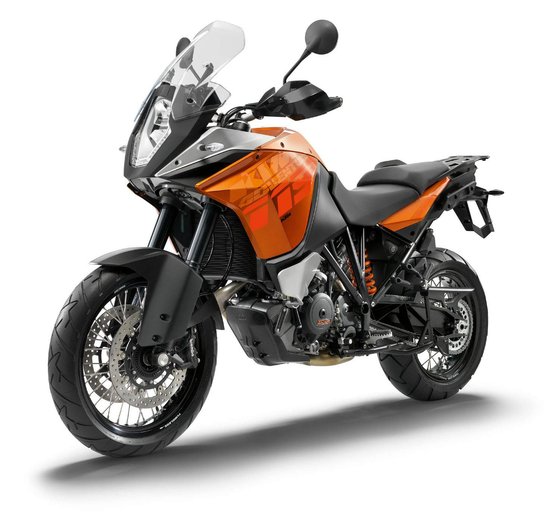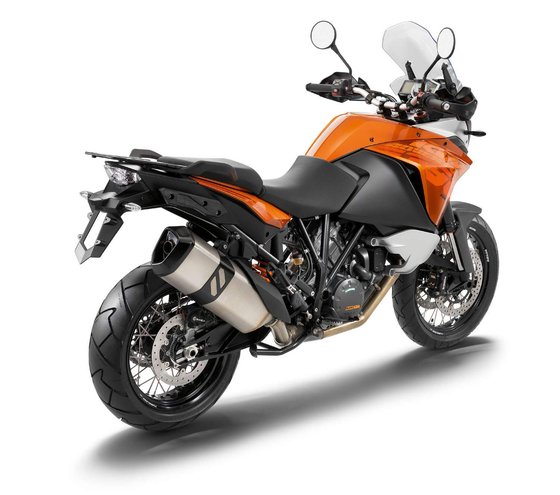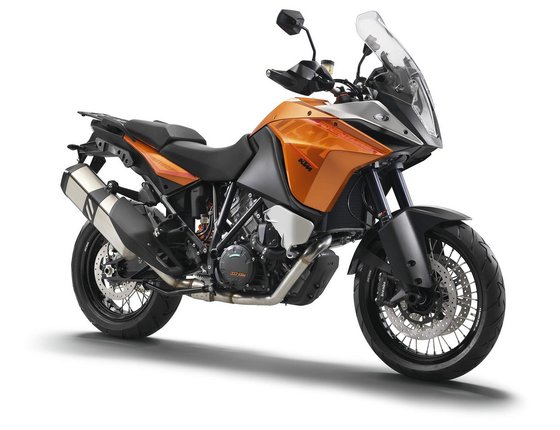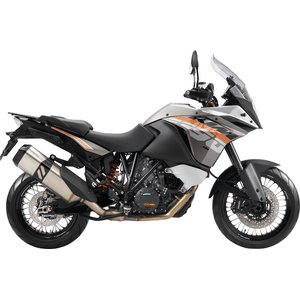KTM 1190 Adventure (2013–2016): The Orange Revolution in Adventure Motorcycling

When KTM unleashed the 1190 Adventure between 2013 and 2016, it didn’t just enter the adventure bike segment—it redefined it. This Austrian beast blends raw power, cutting-edge electronics, and off-road DNA into a package that feels as at home carving canyon roads as it does traversing gravel trails. After spending time with this machine, it’s clear why it remains a benchmark for riders seeking uncompromising versatility.
The Heart of the Beast: Engine Performance
At the core of the 1190 Adventure lies its 1195cc, 75° V-twin engine—a derivative of KTM’s RC8 superbike. With 150 hp (110 kW) and 124.8 Nm (92.2 lb-ft) of torque, this powerplant is anything but subtle. The first twist of the throttle reveals a surge of linear power that builds aggressively from 3,000 rpm to its 10,250 rpm redline. What’s remarkable is how civilized it feels—vibration is minimal thanks to dual counterbalancers, and the ride-by-wire system delivers buttery-smooth throttle response.
- Fuel efficiency: Despite its firepower, the 1190 sips fuel conservatively. Expect 5.5–6.2 L/100 km (42–38 MPG) in mixed riding, translating to a 380–420 km (236–261 mi) range from its 23L tank.
- Slipper clutch: The hydraulically actuated PASC clutch prevents rear-wheel hop during aggressive downshifts and reduces lever effort by 20%, a blessing in stop-and-go traffic.
The engine’s character shifts with its four ride modes:
- Sport: Full 150 hp, minimal traction control (TC) intervention.
- Street: Balanced power delivery with moderate TC.
- Rain: Limits output to 100 hp and prioritizes stability.
- Off-Road: Allows controlled rear-wheel slip (up to 100% overspin) for dirt traction.
On-Road Dynamics: A Sportbike in Disguise

Don’t let the ADV styling fool you—the 1190 is a tarmac scalpel. The chromoly steel trellis frame and WP suspension (190mm travel front/rear) strike a perfect balance between agility and stability. Flicking the bike into hairpins feels intuitive, with a 26° rake and 119.8mm trail providing quick steering without nervousness.
- Braking: Dual 320mm front discs with radially mounted Brembo 4-piston calipers offer surgical precision. The Bosch 9ME Cornering-ABS is seamless, even when leaned over at extreme angles.
- Tires: The stock Continental Trail Attack 2 tires (120/70-19 front, 170/60-17 rear) grip like velcro on asphalt, though they’re less enthusiastic in mud.
On a spirited ride through mountain passes, the 1190’s electronics shine. The Motorcycle Stability Control (MSC) system—a first in its class—combines lean-sensitive TC and ABS, allowing confident throttle punches mid-corner. Switch to Off-Road ABS mode, and the rear brake becomes unlockable for dirt slides while the front retains modulated stopping power.
Off-Road Credentials: More Capable Than Expected

With 220mm ground clearance and a kerb weight of 230kg (507 lbs), the 1190 isn’t a Dakar racer—but it’s surprisingly competent off-road. The key is managing expectations: this is a bike for fire roads and mild trails, not single-track.
- Standing ergonomics: The tapered aluminum handlebar and adjustable footpegs (10mm up/back) create a natural standing position. Removing the rubber peg inserts improves boot grip.
- Suspension tuning: In Off-Road mode, the WP-EDS monoshock softens damping for rocky terrain. Preload adjustments accommodate luggage or a passenger.
- Wheel durability: Tubeless spoked wheels (19” front/17” rear) withstand hard impacts, though swapping to TKC80 tires is advisable for serious dirt work.
The TC’s Off-Road mode is a revelation, permitting just enough wheelspin to dig through loose surfaces without feeling artificial. Heat from the rear cylinder’s exhaust is noticeable at low speeds but manageable with aftermarket heat shields.
Comfort and Ergonomics: Touring Refined
KTM prioritized adaptability with the 1190:
- Seat height: Adjustable from 860–875mm (33.9–34.4”), though the firm 3D foam may test patience on 6+ hour rides. Many owners opt for aftermarket seats.
- Wind protection: The manually adjustable windscreen reduces buffeting, but taller riders might crave an aftermarket extension.
- Luggage: Integrated rack supports KTM’s 37L panniers (sold separately), maintaining a slim profile for lane-splitting.
Vibration is virtually absent below 5,000 rpm, making highway cruising serene. The 6-speed transmission’s tall gearing hums at 4,000 rpm at 120 km/h (75 mph), though overtaking requires just a downshift to unleash the V-twin’s midrange punch.
Technology: A 2016 Bike in 2013 Clothing
The 1190’s electronics were revolutionary for its time:
- TFT Display: The VDO dashboard provides tire pressure, fuel economy, lean angles, and even a gearshift indicator. Menus are intuitive via left-bar controls.
- Electronic Suspension Adjustment (ESA): Optional on later models, allowing on-the-fly damping adjustments.
- LED Lighting: Daytime running lights enhance visibility, though auxiliary lights are recommended for night off-roading.
Owners praise the 15,000 km (9,320 mi) service intervals—double many competitors’. Valve checks are infrequent due to DLC-coated followers, though accessing the rear cylinder requires patience.
Competition: How the 1190 Stacks Up
1. Ducati Multistrada 1200 (2010–2014)
- Pros: Sexier design, Skyhook suspension, 17” cast wheels for sportier tarmac handling.
- Cons: Higher seat (870mm), shorter service intervals (12,000 km), less off-road focus.
2. BMW R1200GS (2013–2016)
- Pros: Telelever front suspension, iconic status, superior dealer network.
- Cons: Heavier (238kg dry), 25hp deficit, shaft drive limits wheel customization.
3. Yamaha Super Ténéré (2010–2020)
- Pros: Bulletproof reliability, lower cost, shaft drive.
- Cons: Anemic 110hp engine, agricultural electronics, bland styling.
Verdict: The 1190 dominates for riders prioritizing power-to-weight ratio and tech. The BMW suits traditionalists, while the Ducati appeals to pavement-focused enthusiasts.
Maintenance: Keeping the Adventure Alive
The 1190 is reliable but demands meticulous care:
1. Oil Changes: Every 15,000 km with 3.6L of 10W-50 JASO MA oil. Use a spin-on filter (e.g., Hiflofiltro HF303RC) for easier swaps.
2. Valve Checks: First inspection at 30,000 km. Intake: 0.10–0.15mm, exhaust: 0.25–0.30mm (cold).
3. Brake Fluid: Replace DOT 4 annually. Upgrade to braided lines (e.g., Galfer) for improved feel.
4. Chain Maintenance: Clean the X-ring chain with kerosene and lubricate every 500km. Replace sprockets (17T/42T) as a set.
Common Upgrades at MOTOPARTS.store:
- Seat Concepts Comfort Seat: Adds 2cm of plush foam for marathon days.
- SW-Motech Crash Bars: Protect the engine during off-road tumbles.
- Arrow Exhaust: Sheds 8kg and amplifies the V-twin growl without compromising fueling.
Conclusion: The Ultimate All-Rounder?
The KTM 1190 Adventure isn’t perfect—its seat frustrates, and the learning curve for electronics is steep. Yet, no other bike in its era so brilliantly bridges sport-touring exhilaration and off-road curiosity. For riders who refuse to choose between the Alps’ switchbacks and a Baja dirt track, the 1190 remains a compelling, adrenaline-fueled companion. As one owner aptly said: “It’s not a motorcycle—it’s a passport.”
Specifications sheet
| Engine | |
|---|---|
| Stroke: | Four-stroke |
| Ignition: | Keihin EMS with RBW, twin ignition |
| Max power: | 110 kW | 148.0 hp |
| Max torque: | 125 Nm |
| Fuel system: | Electronic Fuel Injection (EFI) with ride-by-wire |
| Max power @: | 9500 rpm |
| Displacement: | 1195 ccm |
| Max torque @: | 7500 rpm |
| Configuration: | V |
| Cooling system: | Liquid |
| Compression ratio: | 12.5:1 |
| Lubrication system: | Forced oil lubrication with 3 rotor pumps |
| Number of cylinders: | 2 |
| Dimensions | |
|---|---|
| Wheelbase: | 1560 mm (61.4 in) |
| Dry weight: | 212 |
| Wet weight: | 230 |
| Seat height: | 860–875 mm (33.9–34.4 in) |
| Overall width: | 925 mm (36.4 in) |
| Overall height: | 1460 mm (57.5 in) |
| Overall length: | 2290 mm (90.2 in) |
| Ground clearance: | 220 mm (8.7 in) |
| Fuel tank capacity: | 23 L (6.08 US gal) |
| Drivetrain | |
|---|---|
| Final drive: | chain |
| Transmission: | 6-speed, hydraulically operated wet clutch |
| Rear sprocket: | 42 |
| Front sprocket: | 17 |
| Primary gear ratio: | 40:76 |
| Secondary gear ratio: | 17:42 |
| Electronics | |
|---|---|
| ABS: | Bosch MSC with lean-sensitive cornering ABS |
| Display: | VDO multi-function cockpit with tire pressure monitoring |
| Rider modes: | Sport, Street, Rain, Off-Road |
| Traction control: | Lean-sensitive MTC (Motorcycle Traction Control) |
| Suspension adjustment: | WP-EDS electronic damping system (preload and damping) |
| Maintenance | |
|---|---|
| Rear tire: | 170/60z-17 |
| Engine oil: | 10W50 |
| Front tire: | 120/70z-19 |
| Brake fluid: | DOT 4 / DOT 5.1 |
| Spark plugs: | NGK LKAR9BI-9 (inner), NGK LMAR7A-9 (outer) |
| Spark plug gap: | 0.8–0.9 mm |
| Coolant capacity: | 2.4 |
| Forks oil capacity: | 1.35 |
| Engine oil capacity: | 3.6 |
| Engine oil change interval: | Every 15,000 km or 1 year |
| Valve clearance (intake, cold): | 0.10–0.15 mm |
| Valve clearance check interval: | 24,000 km (15,000 mi) |
| Valve clearance (exhaust, cold): | 0.25–0.30 mm |
| Recommended tire pressure (rear): | 2.9 bar (42 psi) |
| Recommended tire pressure (front): | 2.4 bar (35 psi) |
| Chassis and Suspension | |
|---|---|
| Frame: | Chromium-Molybdenum steel trellis frame, powder coated |
| Rear brakes: | 1 x 267 mm disc, 2-piston caliper (ABS) |
| Front brakes: | 2 x 320 mm discs, 4-piston radial calipers (ABS) |
| Rear suspension: | WP-EDS Monoshock, 210 mm travel |
| Steering damper: | WP steering damper |
| Front suspension: | 48mm WP USD forks, 190 mm travel |



















